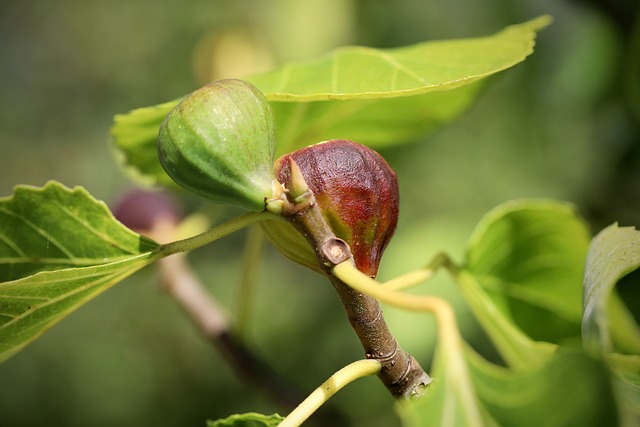Is There an Odd Connection Between Flies and Figs?
For several generations, people have enjoyed figs for their rich flavour and a variety of health benefits due to their sweet and juicy pulp. But a common query is if flies lay their eggs in these delicious fruits. To learn the truth about this widely held question, we’ll examine the curious relationship between figs and flies in this article.

The Fig Wasp Life Cycle
The fig wasp must be introduced in order to fully grasp the interaction between flies and figs. The pollination of figs is greatly aided by the little insects known as fig wasps. They enter the fruit through a natural orifice known as the ostiole after becoming drawn to the fig’s aroma. Female fig wasps transfer pollen from one fig to another, promoting cross-pollination, resulting in the development of seeds and fruit on fig trees.
The Mutualistic Relationship
Observing how mutualistic and interconnected the life cycles of figs and fig wasps is intriguing. Female fig wasps lay their eggs and distribute pollen in the fig’s ovary. As they deposit their eggs, the wasps pollinate the fig flowers, producingthe production of seeds by the fig tree. Some of the seeds that grow are consumed by larvae developed from the eggs as they develop. When fully matured, male wasps emerge first, and their sole purpose is to bore holes in the fig so that the females can flee. The females then take off from the fig in order to resume the pollination cycle.

Fungus gnats are the unwanted guests.
Although there is a mutualistic relationship between fig wasps and figs, fungus gnats, also called fruit flies, can also occasionally be found in figs. Fungus gnats, which may be present if the fig has been allowed to overripen or has minor damage, are drawn to the sweet perfume of ripe figs. It’s important to keep in mind that, unlike fig wasps, fungus gnats do not typically occur as part of the fig’s reproductive cycle.
Utilisation and cleanliness
It’s important to understand that fig wasps and fungus gnats are not harmful to human health when they are found in figs. Two examples of naturally existing insects that are vital to the ecology are fig wasps and fungus gnats. The fig’s within creates a protective atmosphere that wards off contamination from the outside.
Fig Wasps vs. Fungus Gnats: A Detailed Comparison
| Feature | Fig Wasps | Fungus Gnats |
| Classification | Family: Agaonidae | Family: Mycetophilidae and Sciaridae |
| Size | Typically less than 2mm, | 1-3mm in length |
| Appearance | Tiny, often wingless insects with a specialized body for entering figs | Slender, mosquito-like insects with long legs and clear wings |
| Habitat | Found in and around fig trees | Commonly found in moist environments, especially overwatered plants |
| Life Cycle | Unique relationship with figs.Females enter figs to lay eggs, pollinating the fig in the process | Complete metamorphosis:egg, larva, pupa, and adult, |
| Diet | Larvae feed on fig tissues; adults feed on fig pollen | Larvae feed on fungi and organic matter in soil. Adults feed on nectar |
| Ecological Role | Crucial for pollination of fig trees, which are keystone species in many ecosystems | Help in decomposition by consuming fungi in the soil |
| Human Interaction | Mostly beneficial due to, their role in pollinating figs, which are consumed worldwide | Often considered pests, in greenhouses and indoor plants due to their love for moist conditions |
| Reproduction | Female wasps lay eggs inside figs.Larvae develop inside and emerge as adults | Lay eggs in moist soil. Larvae grow into pupae, from which adults emerge |
| Known Predators | Birds, spiders, and other larger insects | Predatory mites, nematodes, and other insects |
| Interesting Fact | There’s a specific fig wasp species for almost every fig tree species | Fungus gnat larvae can glow in the dark, a phenomenon called bioluminescence |
Conclusion
A fantastic example of mutualism in which both species benefit from one another is the relationship between figs and fig wasps, which is deeply interconnected within the structure of nature’s complicated relationships. The reproduction and pollination processes of fig trees are aided by the fig wasp life cycle, but the unintentional presence of fungus gnats does not compromise the quality or safety of figs. The next time you enjoy in a juicy fig, remember that fig wasps are an essential component of the delicate dance that results in the delicious fruit, and that the sporadic presence of fungus gnats is merely a reminder of the intricate relationships that exist in nature.

Please answer this question: Do flies lay eggs in figs
In fact, flies generally do not lay their eggs in figs. The flying creatures most usually associated with figs are fig wasps, which are vital to fig production. Female fig wasps lay their eggs within the ovary of the fig to aid in the fruit’s growth. Notwithstanding the fact that they may occasionally be found nearby, other insects like fungus gnats do not often take part in the fig’s normal reproductive cycle. The presence of fig wasps in figs is a natural and favorable process for both the fig and the fig wasp as part of the ecological relationship among these two species.
